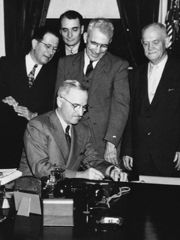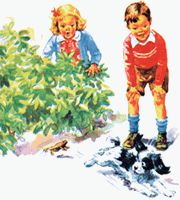

|
 |

December 15, 1999
1920s-1940s
Graham A. Barden | Walter Barnette | Arthur
Bestor | Benjamin S. Bloom | Henry Chauncey | George S.
Counts | Frank W. Cyr | Dick
and Jane | Robert M. Hutchins | The Little Rock Nine | Thurgood Marshall | Felicitas
and Gonzalo Mendez | Jonas Salk | Dr. Seuss | John Stelle | Harry S. Truman | Ralph W.
Tyler | Paul W. Updegraff | Earl Warren
'Regardless of
Lineage':
Felicitas and Gonzalo Mendez
|
| When their children were turned away from
an all-Anglo school in
Orange County, Calif., and told to go to a school for Mexican-
Americans, Felicitas and
Gonzalo Mendez fought back.
In 1945, the farming couple filed
a lawsuit on behalf of
5,000 Latinos against the county's four school districts, seeking
the right for their
children to be educated in the same school as Anglo children.
Felicitas Mendez, a native of Puerto Rico, managed the
family's rented, 40-acre
asparagus farm so that her husband, a Mexican immigrant, could
work on the cause full
time. Thurgood Marshall, then the top lawyer for the National
Association for the
Advancement of Colored People, filed a friend-of-the-court brief
in the case.
A federal judge in 1946 ruled in favor of the Latinos,
rejecting the argument that the
schools for them and for Anglos were "separate but
equal." Judge Paul J.
McCormick wrote that "the paramount requisite in the
American system of public
education is social equality. It must be open to all children by
unified school
association regardless of lineage."
Though the school districts had argued that they segregated
Latino children because of
language differences, the judge pointed out that the districts
didn't even test all
children on their language ability.
Judge McCormick's decision was upheld on appeal a year later,
launching integration of
schools in Orange County. And while the case showed that
segregation was not just an issue
for African-Americans, it helped point the way to the U.S.
Supreme Court's historic 1954
decision in Brown v. Board of Education of Topeka.
Gonzalo Mendez died in 1964, and Felicitas Mendez in 1998.
—Mary Ann Zehr |
George S. Counts
American education
reinforces class differences, this Teachers College academic argued
in the 1930s, and he called for educators to use the schools to
reshape society along socialist lines. He later broke with the far
left; elected president of the American Federation of Teachers in
1939, he led a successful campaign to expel Communist-dominated
locals from the union.
Arthur Bestor
University of Illinois historian whose 1953 book, Educational
Wastelands, skewered "professional educationists" for abandoning
traditional disciplines and intellectual rigor. It's still a favorite
among advocates of high academic standards.
The Little
Rock Nine
Melba Pattillo Beals, Elizabeth Eckford, Ernest
Green, Gloria Ray Kalmark, Carlotta Walls Lanier, Terrence Roberts,
Jefferson Thomas, Minnijean Brown Trickey, Thelma Mothershed-Wair.
Arrayed against these teenagers chosen to integrate the Little Rock
schools under federal court order in 1957 were Gov. Orval Faubus, the
Arkansas National Guard, and jeering mobs of local whites. But on
Sept. 25, they walked through the doors of Central High School,
escorted by federal troops mobilized by President Eisenhower in what
was considered the gravest constitutional crisis since the Civil War.
Harry S. Truman

|
|
U.S. Department of Agriculture
|
The National School Lunch
Act, which the 33rd president signed in 1946, sought to overcome
serious nutritional deficiencies in many children by providing at
least one healthy meal each school day. Today, the program serves
some 26.1 million youngsters in public and private schools, including
more than 15 million poor children who receive their meals for free
or at a reduced price.
Thurgood
Marshall
A titan of the civil rights movement who, as the
chief legal strategist for the National Association for the
Advancement of Colored People, launched the all-out attack on school
segregation that resulted in the Supreme Court's 1954 decision in
Brown v. Board of Education of Topeka. Named to the high court
himself in 1967, Marshall continued to argue passionately for the
maintenance and expansion of efforts to integrate the nation's public
schools.
Graham A. Barden
Despite desperate conditions in many of the nation's
schools—and strong support in Congress—attempts after
World War II to create
federal aid programs stumbled over two issues: whether to include
Catholic schools, and whether Southern states would be allowed to
spend the money on their segregated systems. Barden, a North Carolina
Democrat, used his leadership of the House education committee to
stifle aid bills throughout much of the 1950s.
Frank
W. Cyr
The father of the yellow school bus. In 1939, Cyr,
a Teachers College professor, gathered state officials, school
leaders, and engineers to set first-ever safety standards for school
buses, including the now-famous hue.
Walter Barnette
Jehovah's Witness from West Virginia whose challenge to a
state rule that required students to recite the Pledge of Allegiance
led to a ringing 1943 Supreme Court decision striking down such
measures.
Earl Warren
Thurgood Marshall brought the issue of school segregation
before the Supreme Court. But it was the skill of Chief Justice Earl
Warren that united the fractious court behind a single, unanimous
opinion, contributing enormously to the moral force of the Brown
decision, which he wrote himself.
Ralph W. Tyler
The Eight-Year Study, launched in 1932, retooled the
curriculum along progressive lines in some 30 high schools and waived
regular college-admissions requirements. Tapped to gauge the impact,
the University of Chicago's Tyler found an edge for progressive-
school graduates.
Robert M.
Hutchins
Named president of the University of Chicago in
1929 at the age of 30, he soon emerged as an eloquent champion of a
common liberal arts education, battling what he saw as the
utilitarian focus of progressive educators.
Jonas Salk
His 1955
vaccine was the breakthrough in the war against polio and brought a
sigh of relief to parents worldwide. Salk's injected vaccine and
Albert Sabin's oral vaccine, approved in 1960, virtually eradicated
the crippling childhood plague.
John Stelle
The former Illinois governor led the American Legion when it
proposed and drafted the GI Bill. The Servicemen's Readjustment Act
of 1944 opened the doors of higher education to some 7.8 million
veterans and changed the perception that college was beyond the reach
of most Americans.
Paul W.
Updegraff
This Oklahoma taxpayer set out to prevent the
state from issuing paychecks to public employees, including teachers,
who had not taken an anti-subversive loyalty oath. But his lawsuit
had the opposite effect: The Supreme Court declared the oath
unconstitutional in 1952, the first in a line of decisions
overturning laws that, in the cause of fighting Communism, imperiled
the rights of educators.
Dr. Seuss
Theodor Seuss Geisel's whimsical drawings and playful rhymes
have inspired a love of books in young readers for decades. His long
list of titles includes And To Think That I Saw It on Mulberry
Street, published in 1937, The Cat in the Hat, How the
Grinch Stole Christmas, Horton Hears a Who, and Oh, The
Places You'll Go, a best seller at the time of his death in 1991.

|
|
Scott, Foresman, and Co.
|
Dick and Jane
From the '30s to the '70s,
millions of children formed letters into words and words into
sentences ("See Spot run") with the reading primers featuring this
cheerful brother-sister duo, along with baby sister Sally, dog Spot,
and Puff the cat.
Henry Chauncey
Multiple-choice tests have become the primary means by which
students are sorted, classified, and categorized, and the Educational
Testing Service is the most famous player in the business. Chauncey,
a former assistant dean at Harvard University, founded the Princeton,
N.J.-based nonprofit organization in 1948. Today, its sat is an
object of awe and foreboding for millions of American teenagers.
Benjamin S. Bloom
University of Chicago
researcher who in 1956 headed a group of psychologists that devised a
system to classify levels of intellectual behavior. "Bloom's
Taxonomy" ranked skills from the simple recognition of facts on up to
"higher order" activities such as analysis and criticism. His finding
that the first few years of human life were critical helped spur the
creation of Head Start.
© 1999 Editorial Projects in Education  Vol. 19, number 16, page 30-31 Vol. 19, number 16, page 30-31
|




